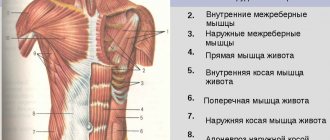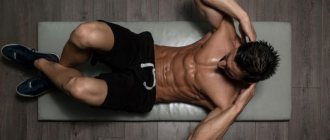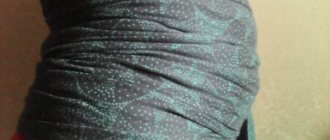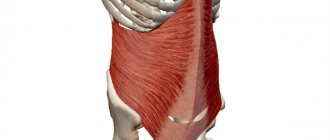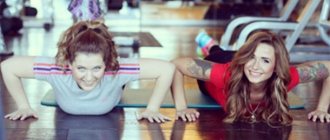It just seems that after giving birth, women are only occupied with the baby, and do not have enough time and energy for everything else. Modern women try to quickly return to an active life, take care of themselves, and correct their figure. It is important that in pursuit of the same volumes, the young mother does not harm her own health. With grade 3 diastasis of the abdominal muscles, physical activity is contraindicated. We’ll talk further about how to determine the degree of diastasis after childbirth and what exercises to perform to eliminate it.
Degrees of diastasis and treatment methods
The degree of diastasis can be determined independently. To do this, lie on your back, bend your legs, press your feet and head to the floor. The abdominal muscles should be completely relaxed, one hand should be placed behind the head, the other should be placed on the white line above the navel - a conventional line that is located in the center of the abdomen.
If your fingers fall through when lifting your head:
- up to 1.5-2 cm, discrepancy of 5-7 cm - this is the first degree;
- by 2-2.5 cm, and the discrepancy is up to 7-9 cm, and from the side it is noticeable that the oblique muscles are flabby - the second degree.
Additional symptoms are minor epigastric pain, nausea, and sometimes constipation.
A well-designed set of exercises for diastasis after childbirth will help you cope with the problem at home.
If the muscles diverge significantly and their bulging is visible through clothing, you should not make any independent attempts to cope with the problem. This can provoke displacement of internal organs, the development of a hernia, and atrophy of muscle fibers. Treatment of diastasis in this case is only surgical.
Trying to “pump up” on your own can lead to limited ability to work.
Complications
Diastasis of the rectus abdominis muscles after childbirth can cause not only aesthetic harm, but also a health threat. Possible complications:
- displacement and disruption of internal organs;
- umbilical hernia;
- indigestion - heartburn, constipation, belching;
- increased risk of malignant tumors;
- curvature of the spine with frequent back pain;
- atrophy of the abdominal muscles, which greatly reduces the ability to pump them up;
- more protracted, difficult subsequent labor;
- pain in the abdomen, both at rest and when moving or bending.
Article on the topic: Radicular syndrome: causes, symptoms, diagnosis, treatment
How to remove diastasis of the abdominal muscles: recommendations
Figure correction begins 2-2.5 months after birth - when hormonal levels are completely normalized. All this time you need to follow special rules so that the condition does not worsen.
Knowing about your problem, you should avoid actions that provoke an increase in intra-abdominal pressure. Since when caring for a baby it is impossible not to hold him in your arms, you should know how to do it correctly.
You cannot lift a baby—and other heavy objects—with a jerk, like a weightlifter lifting a barbell, with straight arms. The arms must be bent, if the “load” slides along the body, the muscles tense slightly (available weight is up to 6 kg, you cannot lift more).
In the case when the baby has to be rocked in your arms, it is necessary to wear a postpartum bandage.
When coughing or sneezing, the press should be pressed with the palm of your hand; the stomach should not be allowed to inflate.
You need to get out of bed very carefully, first rolling onto your side. Carefully get up from the chair - straining your legs. To make it easier to get up, press your stomach with your palm, transfer your weight to one leg, and lean on the other.
The hardest thing is learning to sleep properly. Many women are accustomed to sleeping on their stomachs and after giving birth quickly return to their previous habits. If you have diastasis problems, it is recommended to sleep on your side or back. To avoid accidentally rolling over, you can lie on your side in advance and place a folded blanket or pillow under you. This will help keep the linea alba from stretching further.
Exercises must be done regularly. If there is not enough time for daily exercise, then you can set aside 2 days for recovery. On these “free” days, an auxiliary complex is performed to strengthen the abdominal muscles. During the day, the stomach is pulled in and held for 25-30 seconds. At least 25 repetitions are required.
Diastasis of the rectus abdominis muscles: causes, types, pathogenesis
The rectus abdominis muscles (RAM) occupy the space from the costal arch to the pubic bone. Muscle separation is usually observed at the level of the navel and above the navel - in these areas it is maximum. Below there is a narrowing of the distance between the halves of the rectus muscle: in some they touch closely below the navel.
In the normal state of the rectus muscles:
- the straight line width (SLW) in the lower part of the sternum (the level of the xiphoid process) should be no more than 1.5 cm;
- at a level located 3 cm above the navel - the BBL should be no more than 2.2 cm;
- 2 cm below the navel - no more than 1.6 cm.
(These standards were proposed by the Swiss specialist Gertrude Beer).
Divergence of the rectus abdominis muscles is established if the muscles diverge more than 2.7 cm at the level of the navel, and more than 2.2 cm at the level of 3 cm above the navel.
In pregnant women, diastasis most often occurs, not exceeding 5 cm. Cases of large discrepancies of the mc up to 10 cm and above are quite rare.
Causes of diastasis
- The main cause of diastasis in women is pregnancy, and here it is a natural phenomenon.
- In newborns, prematurity and weakening of the anterior peritoneal wall.
- Male diastasis is rare and is associated with tissue degeneration (this is mainly observed in HIV-infected patients).
Diastasis in women gradually regresses after childbirth, usually within two months, but a longer recovery is possible. You can take some measures if the symptoms of discrepancy do not disappear within a year after the birth of the child. This can happen in about a third of women giving birth.
Pathogenesis of diastasis in pregnant women
- In late pregnancy, the growing fetus in the womb puts pressure on the anterior wall of the peritoneum and stretches it.
- Changes also occur in the endocrine system of a pregnant woman: the hormone relaxin is produced, which causes stretching of connective tissues (this is how nature prepares a woman for childbirth);
- under the influence of relaxin, collagen production decreases, and it is this that ensures the strength of all soft joints, including the white line;
- relaxin affects not only the birth canal, but also the abdominal wall.
- anatomical features of the connections of the rectus and oblique abdominal muscles;
Additional factors contributing to diastasis are:
- woman's age is over 45 years;
- repeated births;
- large fruit size;
- multiple pregnancy;
- history of cesarean section;
- weakness of the muscular system;
- increased volume of amniotic fluid;
- high body weight and obesity.
All these factors increase the separation of the rectus muscles during pregnancy.
Diastasis in a pregnant woman begins to be observed approximately from the middle of the fourth month of pregnancy (14th week).
Classification of diastasis
There is no single standard for determining the types and degrees of muscle discrepancy. They usually establish the fact of the discrepancy and select methods to eliminate it, if the woman herself so desires.
The best known is the international classification proposed by Nahas, who divided diastasis into the following types:
- A - isolated divergence of the rectus muscles after childbirth.
- B - protrusion of the peritoneum (stretching of the walls).
- C - connection of the rectus muscles with the costal arch, mainly in the lateral zone.
- D - abdominal muscle separation + poor waistline.
Age classification
It is based on the results of a study of two age groups:
- first - up to 45 years;
- the second - after 45.
The following are considered normal indicators:
- discrepancy at the navel level is no more than 2.7 cm (for both age groups);
- diastasis no more than 1 cm above the navel (for the first group) and no more than 1.5 cm (for the second);
- the divergence of the muscles under the navel is no more than 9 and 14 mm for the 1st and 2nd groups, respectively.
A set of exercises after childbirth
At home, it is easy to perform the following exercises for diastasis of the abdominal muscles. For most of them, they take a fairly comfortable position - lying on their back. The load increases gradually - from 10 repetitions to 25.
In case of second degree discrepancy, the first classes are carried out in a postpartum bandage.
- They lie on their backs, with their head and limbs pressed to the floor. Then the head and shoulders are raised and the position is fixed for 30 seconds. If diastasis is of the second degree, the recommended modification is “hundred”. It differs in the starting position - the legs are bent at the knees, the feet are pressed to the floor. Only the rectus muscles are involved.
- The well-known popular “cat” helps to simultaneously strengthen the rectus, oblique and transverse muscles. Focus on your knees and palms. Next, they arch their back like a cat and pull in their stomach, lowering their head, and then relax again to their original position. You need to pay attention - the exercise begins with arching the back as you exhale, and returns to the starting position as you inhale.
- You should roll over onto your back again - rolling onto your side from the crampon position. Starting position – as in the first exercise. Then the legs are bent and the feet are placed on the floor. The pelvis is torn off for 30 seconds, fixing the position.
- To do the next exercise, you need an additional accessory - a towel. Pose - as in exercise 3, a towel stretched under the waist. You need to take the towel with your hands by the ends, stretch your arms forward, slightly bending at the elbows. As you exhale, raise your shoulders and tighten your waist with a towel, and while inhaling, return to the starting position.
- Very simple exercises that simultaneously strengthen the rectus and transverse muscles. The pose is the same - lying on your back, legs bent. The legs are raised one by one, and while they are raised, they clap their palms on the floor - 5-6 times - as if they are splashing water. After the leg is lowered, while exhaling, turn the hands over and perform reverse movements.
After 3-4 weeks of regular exercise, the exercise can be complicated - add lifts of 2 legs at the same time, or hold the ball between your knees.
The following exercise can be performed at the final stage of strengthening the abdominal muscles - when the discrepancy is almost imperceptible. All muscles are worked out - obliques, rectus, transverse. You need to stand in a knee-elbow position, place your palms (you should pay attention to this) opposite your shoulders. The stomach is pulled in, the right leg and left arm are raised and extended parallel to the floor. The limbs are lowered and the stomach is relaxed. The movements alternate.
Treatment of diastasis
Before starting treatment, study the list of actions that are prohibited if you have diastasis:
- take poses that create pressure on the midline of the press, increase intra-abdominal pressure, stretch the abdominal wall - navasana, mayurasana, nauli, hand balances, jumping, push-ups, side bends, bridges, almost all exercises for training the press;
- lift weights;
- ride a bike.
To speed up the recovery process for diastasis after childbirth, follow these tips:
- Put on the brace before picking up your baby.
- If you cough, press your hand on your stomach to prevent excessive bloating.
- Don't sleep on your stomach. This will increase your blood pressure, which will have a negative impact on your abdominal muscles.
- Keep your back straight and don't slouch.
- Get out of bed and lie down on your side.
Treatment of diastasis depends on the stage of the disease. So, in order to achieve a good effect in the first and second stages, you should use supporting devices, perform therapeutic exercises, anti-cellulite massages and eat right. A balanced diet includes a daily intake of protein foods and fiber-rich foods - grains, vegetables and fruits. In the third stage, only surgical intervention will help. Among the operations are abdominoplasty, tension plastic, and traditional suturing methods.

Support devices
A postpartum bandage will help remove a protruding belly. Doctors recommend starting to wear it already in the last months of pregnancy, easing the load on the muscles and holding back severe stretching, and after giving birth, wear it with the wide side on the body. Therefore, buy a universal bandage. Wear it for 3 hours continuously, then take it off, rest, and put it on again. Calculate wearing time so that it does not exceed 12 hours per day. If you had a caesarean section, you can buy a bandage to help the stitches heal.
In addition to the bandage, corrective underwear is used when the rectus abdominis muscles diverge. Wide belts and tight pants not only close the muscles, but visually make the figure slimmer, hiding fat folds. High-quality panties will also act as a corset, supporting the spine in the desired position - this way you will avoid herniated discs. At the same time, shapewear cannot be worn immediately after the maternity hospital, like a bandage. It is allowed to be worn only after 3 weeks. Choose this device so that it does not put pressure on the body and does not cause discomfort.
Another modern method in the treatment of diastasis is taping. Tape is a cotton tape with an adhesive backing. It fits tightly to the body, acting as a frame for damaged abdominal muscles. Taping restores abdominal weakness without causing discomfort. The patch is applied in a lying position along the rectus abdominis muscles with a tension of 50%. The tape does not interfere with an active lifestyle and is valid 24 hours a day.
Article on the topic: Characteristics of acute psychoses: causes, symptoms, treatment
Massage
Massage is also useful for diastasis. It accelerates the healing of stretch marks and scars, stimulates metabolism, improves digestion, strengthens and tones the abdominal muscles. When metabolism accelerates, fat deposits leave the depot and are ready for elimination. After a massage with diastasis, the skin becomes elastic and smooth, but before you start doing it, you should consult a doctor and find out if there are any contraindications. There are several types of massage that will help with diastasis after childbirth:
- Manual. After a natural birth, you can start it after 2-3 weeks, after a cesarean birth - at least after 2 months. Lie on your back, bend your knees slightly, lie down for a few minutes, and restore your breathing. After this, gradually increasing the intensity, alternately perform circular and oblique stroking, rubbing, sliding with knuckles, sawing with the edge of the palm, pressing the abdomen inward. Finally, stroke your belly clockwise up to 10 times.
- Hardware vacuum roller LPG. The course and period after which this massage can be done is selected by the doctor. This massage affects subcutaneous fat and skin. As a result, metabolism accelerates, blood circulation improves, swelling disappears, and the abdominal muscles become stronger.
Physiotherapy
An effective way to remove diastasis after childbirth is to perform special exercises for a flat stomach:
- Vacuum. Exhale all the air through your mouth, and then pull your stomach under your ribs. Stay in this position for 10 seconds. Then take a couple of calm breaths through your nose and repeat. The exercise is performed in 4 sets of 10 repetitions (position with the abdomen retracted), on an empty stomach in the morning or after a long break without food during the day.
- Gluteal bridge. Lie on your back with your legs bent and shoulder-width apart. Raise your buttocks as high as possible, drawing in your stomach and tensing your abs. Then lower yourself to the starting position and relax. Do 3-4 sets of 20 repetitions.
- Chin to chest. Lie down in the same position as for the glute bridge. You can hold the ball between your knees. As you exhale, raise your head, resting your chin on your chest and drawing in your stomach. As you exhale, return to your original state. Do 3-4 sets of 20 repetitions.
Surgical intervention
At the third stage of discrepancy, diastasis can only be dealt with through surgery. For this purpose, they began to use an endoprosthesis - a multilayer mesh made of synthetic materials. It covers the area of divergence, where within a month and a half it grows with connective tissue, forming a single structure. The white line turns out to be strong, so it can withstand heavy loads and does not stretch or get damaged. The endoprosthesis is used in operations to eliminate diastasis:
- Cockerling method;
- endoscopic hernioplasty;
- obstructive hernioplasty;
- abdominoplasty;
- laparoscopy.

What not to do with diastasis
Once diastasis recti is detected, activities that increase intra-abdominal pressure should be avoided. Such activities include lifting heavy objects, loudly laughing or coughing, sleeping on your stomach, slouching, and performing classic abdominal exercises. Workouts that lead to belly growth:
- lifting the body from a lying position;
- push-ups, planks and any exercises that focus on the hands or elbows;
- lifting legs straight or bent at the knees from a lying or hanging position, including “bicycle” and “scissors”;
- power crunches;
- yoga practices that place strong pressure on the midline of the abdomen;
- weighted squats and lunges;
- strong backbends, side bends, pull-ups;
- strength exercises using various weights;
- jumping.
What is diastasis
The term refers to the divergence of the rectus abdominis muscles to the left and right of the linea alba. In a healthy person, this distance is less than two centimeters. In difficult cases, it can reach ten centimeters in width. The reasons for the appearance of diastasis are as follows.
- During pregnancy, the uterus grows rapidly and puts strong pressure on the abdominal wall, stretching the ligaments. After childbirth, the doctor will be able to feel the depression in this place.
- The hormone relaxin relaxes muscles and joints, making them soft and elastic. This facilitates the birth process, but also causes pathology.
The highest risk of diastasis is in women carrying twins and expectant mothers who are overweight.

